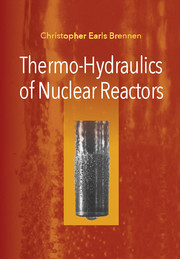7 - Reactor Multiphase Flows and Accidents
Published online by Cambridge University Press: 05 April 2016
Summary
Multiphase Flows in Nuclear Reactors
This and the following sections will include descriptions of how multiphase flow is pertinent to the understanding and analysis of nuclear power generation and nuclear reactor accidents. The focus is on those multiphase issues that arise in the reactor itself, though, of course, there are many multiphase flow issues associated with the conventional components of the power generation process such as the steam generators and steam turbines.
Multiphase flows that might or do occur in a nuclear reactor are most conveniently subdivided into those that occur during nominal reactor operation and those that might occur and have occurred during a reactor accident. Both sets of issues are complex and multifaceted, and many of the complexities are beyond the scope of this monograph. The reader is referred to texts such as Hsu and Graham (1976), Jones and Bankhoff (1977a, 1977b), Jones (1981), Hewitt and Collier (1987), and Todres and Kazimi (1990) for a broader perspective on these issues.
Multiphase Flow in Normal Operation
The most obvious multiphase flow occurring during normal operation is the process of boiling in a BWR core. Sections 6.5.4, 6.5.5, and 6.5.6 described how boiling is initiated within a BWR reactor core (Section 6.5.3), how the flow pattern within the coolant passages would change from bubbly flow to annular flow as the fluid rose (Section 6.2.3), and the circumstances under which the wall film might undergo burnout (Section 6.5.4), leading to the critical heat flux condition (CHF) and a rapid rise in the temperature (Figure 6.9) of the interface between the fuel rod cladding and the coolant. Boiling water reactors are designed to operate at a comfortable margin short of CHF at any location within the reactor. This requires a coupled calculation of the multiphase flow and the neutronics (Section 5.5) as well as a criterion that determines the CHF. For a review of the thermohydraulic data on CHF in nuclear reactors, the reader is referred to Groeneveld and Gardiner (1977).
Void Fraction Effect on Reactivity
In most reactors, it is important to recognize that any change in the geometry of the core or change of phase of its components may alter the reactivity of the reactor.
- Type
- Chapter
- Information
- Thermo-Hydraulics of Nuclear Reactors , pp. 127 - 150Publisher: Cambridge University PressPrint publication year: 2016



